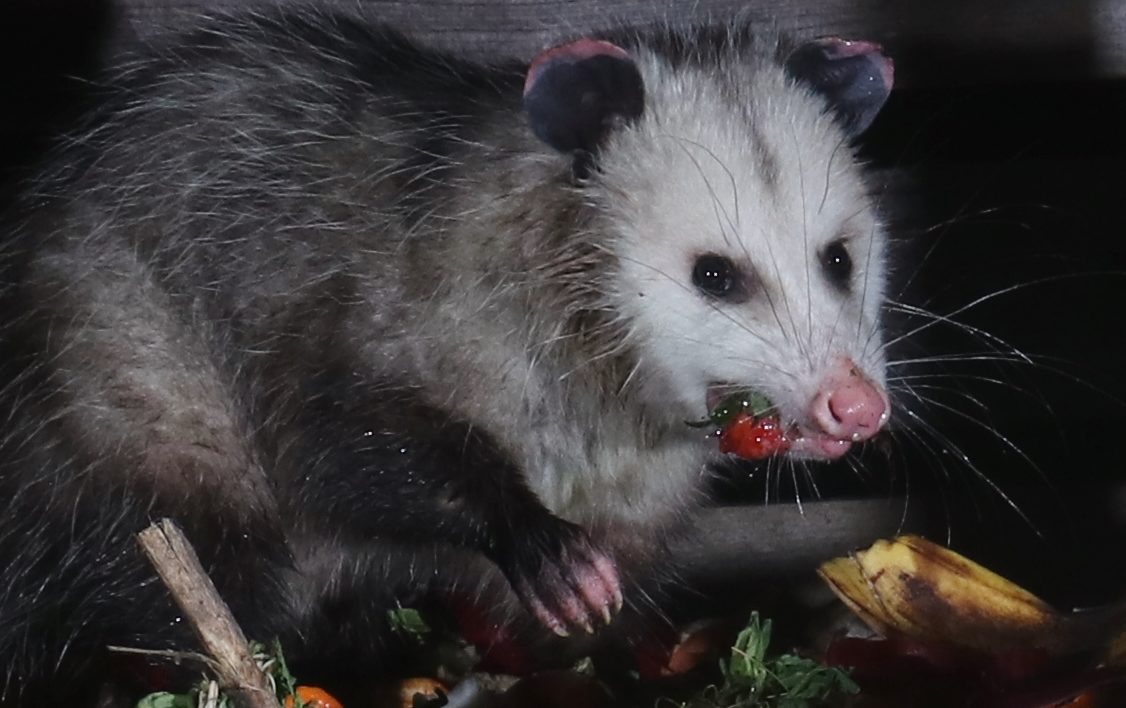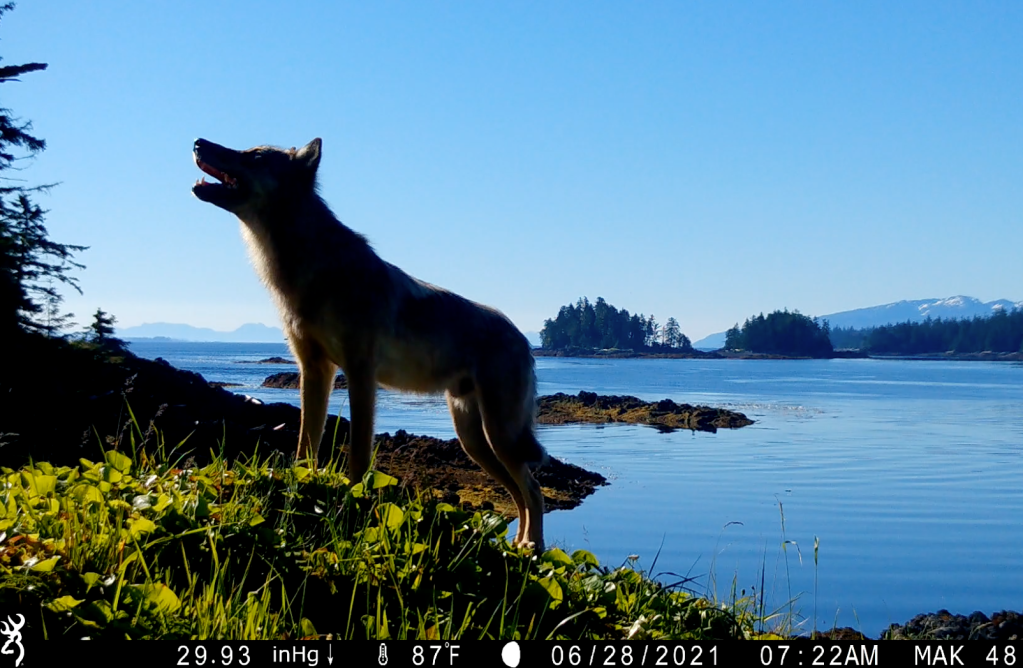Michael Kampnich is telling me about black bears playing in muskeg ponds on Alaska’s Prince of Wales Island, where he lives. When a bear encounters a pond, it seems drawn to it in the same way my 6-year-old son can’t resist a swimming pool. And the bear’s enthusiasm level is similar, too. It’s hard not to see joy as a bear frolics in the water.
A former colleague at The Nature Conservancy, Kampnich is one of the most thoughtful conservationists and astute observers of nature I know. Eight years ago, he showed me around Prince of Wales Island and I was impressed by his woods savvy, his willingness to listen to others and his understanding of the natural landscape born of years of logging, fishing and exploring.
But he has never seen a bear playing in a muskeg pond. At least not in person.
His descriptions were based on photos and videos he obtained from his camera traps this year. ‘It’s the first year I’ve captured bears in ponds,” he says. “But when I shared them on social media, I found other people had obtained similar footage on camera traps. It doesn’t matter if it’s a beaver pond in Wisconsin, a water hole in Nevada or a muskeg pond in Alaska. Bears like to get in these little ponds and play.”
It’s not the first time he’s been surprised at the behavior he’s captured on camera traps. He began when he received a trail camera as a Christmas present eight years ago. Since then, his collection of cameras has grown. He loves capturing images of charismatic species like wolves and bears amidst stunning backdrops.
But Kampnich tells me that perhaps his biggest revelation in all this isn’t about wolves and bears. It’s about how camera trapping has become a great way to connect people to nature. And not just people who live in wildlife-rich places like Alaska. Many are finding surprising creatures roam in their backyards.
“If you look at wildlife photography sites on social media, it’s a lot of professional-level activity,” Kampnich says. “There’s a focus on composition, on getting the perfect shot. With the trail camera community, you find amateurs who have an affinity for wildlife, who enjoy learning about animal behavior and who want to share that enthusiasm.”
Trail cameras were once primarily used by wildlife biologists and deer hunters. But capturing remote images has become a popular hobby for backyard nature enthusiasts. With the pandemic, many people are seeking to better understand and appreciate the nature around them. They’re surprised by the diversity they see just by looking.
And with trail cameras, they’re finding that there’s even more going on when they aren’t looking.
To understand the growth of this nature hobby, and the potential it has for conservation, I turned to one of the most passionate advocates of camera traps, Janet Pesaturo.
Gadgets in Nature
Pesaturo never thought she’d become an expert on camera trapping. In fact, she resisted their use for years. An obsessive wildlife tracker, she took to the woods to get away from gadgetry. Then one day she came across a deer carcass near her yard in Massachusetts. She decided to place a camera and see what was drawn to it.
“When I saw what had visited, I was hooked,” she says. “I became as obsessed as I was with tracking. I made it a personal challenge to capture as many species as I could. I’ve recorded animals doing things I could only imagine when tracking.”
Pesaturo is author of the book Camera Trapping Guide: Tracks, Sign, and Behavior of Eastern Wildlife, an indispensable guide that includes tips for capturing images of 41 species. She also runs the Trail Camera Photos and Videos Facebook group, which has attracted nearly 8,000 members from around the globe.
“I think many people are drawn to it for the same reason I initially wasn’t,” says Pesaturo. “It is a way to incorporate gadgetry into their nature exploration.”
While technology has improved, and some of the photos are studio quality, she says the emphasis has remained on capturing images of cool creatures and behaviors. “A grainy image of an animal doing something unique is as valued as a perfectly composed shot,” she says.
The Citizen Science of Camera Trapping
Pesaturo maintains that camera trapping is, at its heart, an exercise in citizen science. “You are beginning with a question that you want to test,” she says. “Who’s getting in my garden? Who’s eating the compost? Who’s living under the shed?”
But sometimes, the cameras capture creatures or behaviors that have greater scientific value. Certainly, professional researchers utilize trail cameras to track rare or rarely seen wildlife. For backyard enthusiasts, they are more likely to capture interesting behaviors.
“I have video of a porcupine mother playing with a baby,” says Pesaturo. “I have found no documentation of that behavior. Porcupine mothers are often portrayed as being somewhat indifferent.”
But perhaps the greater power of camera trapping is how it reveals another facet of biodiversity all around us. Many think of nature as something “out there” – in wildernesses and natural parks, in the kinds of places shown on nature documentaries. But there’s life all around us, often including cool and surprising mammals.
“We want to see what animals are doing in their natural habitat when no one’s looking,” says Pesaturo. “Usually, when someone puts out a camera trap, they find out they have a lot more wildlife neighbors than they thought.”

As people progress in their camera trapping skills, they often want to focus on specific species, especially elusive and charismatic ones. This requires excellent natural history and observational skills. Knowledge of tracks, scat, and other signs can help in camera placement. One of the things I really loved about Pesaturo’s book is its emphasis on wildlife habits.
Just plunking a camera down and seeing what wanders by may yield an interesting image or two, but it’s a lot more fun to learn an animal’s habits and place the camera to capture compelling photos.
“I emphasize where and when the animal is likely to appear repeatedly on the landscape,” she writes in the book, “because these areas are where camera capture is most likely.”
Ethical Considerations
Of course, as with any nature activity, there are irresponsible practices that can disturb or even threaten wildlife.
Some of the more egregious examples involve camera trap usage in hunting. In some parts of the arid West, as many as 30 trail cameras could be at a single water hole, placed there by professional outfitters – and threatening to scare wildlife from water sources. I’ve seen live trail cameras over bait, with the hunting client then shuttled to the spot when game is sighted. These practices fall outside the scope of recreational camera trapping, of course (but ethical hunters need to be having this discussion).
But placement of camera traps to capture the “perfect image” could potentially disturb wildlife, such as a camera set by a den site. (The same is true of wildlife photography in general). There is much debate in the camera trapping community among the appropriate use of bait and lures.
Some believe that just the presence of a camera trap presents new stresses to wild animals. But I find this unpersuasive, and often promoted by people who believe we should not interact with nature at all. The same arguments could be made against hiking, fishing, photography, or nearly any outdoor activity. Human presence is noticed by nature. But, to my mind, the passion for the natural world such activities instill far outweigh any negatives.
And it’s the same for camera trapping. It leads to a better understanding of the natural world around us – and hopefully, enthusiasts will be inspired to protect habitat for this diversity of creatures.
I admit I am much like Pesaturo was; I have resisted another piece of technology. I’d rather spot wildlife on my own. But looking at the images, the care in setting them up, I can immediately see the appeal. It is an activity that requires field craft and natural history skills. And when you check the camera, you never know what you might find.
“It’s actually a really easy activity to get started,” says Kampnich. “You can set up a camera along a game trail, and you’ll be surprised at what you capture. I love to see the enthusiasm people have for this, how so many people love capturing an image of wildlife activity in a natural setting. These aren’t wildlife biologists. They are simply people who want to connect to nature.”




Great article. I have Janet’s book.
Thank you for these 8 videos.
They were really cool.
I did not watch the first one with the Bear and his extra-long Tapeworms.
Thanks agaion,
Note the tape worm hanging out of the beats behind in the first video!
All true. I lived here for 40 years before I set out a camera trap, and I’m amazed at who I have been living with all this time. Now I’m totally hooked: https://www.youtube.com/channel/UCi2DcoUk01ZJvjMilF9sO5w/videos